
Jon Estrada
Want to make chef Natalie Young’s cinnamon biscuits with berry jam?
Sunday, July 9, 2017 | 2 a.m.
We’ve all mastered eating. Cooking? Well, if you ask Michael Pollan, the activist author crusading to restore our food system, the situation is dire. He found that the average American spends just 27 minutes a day actually using the kitchen — it was an hour in 1965 — and that we cook less than the rest of the world. Blame modern culture, from prepared food being everywhere to our lives being more crammed with work and distractions.
It’s easy to say there isn’t enough time, that it’s too expensive to buy all the tools and spices and impossible to get the techniques, but Pollan insists the only way we can truly connect to and control our food is to make it. Those brave enough to face the crushing failures of the learning process (see: deflated waffles) will tell you that creating a meal becomes joyful and affirming. It can bring you closer to your family, and yourself. It definitely makes you appreciate what’s on your plate.
For inspiration, we talked to some talented chefs in the local scene about how they got into cooking, what every kitchen needs and a favorite simple recipe that will help you build the confidence to fall in love too.
FATIMAH MADYUN, Rao’s
The chef de cuisine at Rao’s always wanted to be a cook. “I had an Easy Bake Oven, and I was a killer,” she says, laughing. “The first real, big thing I tried to make was Black Forest Cake. I pulled a recipe out of my mom’s cookbook. It didn’t go over so well the first time, but I killed it eventually.”
Madyun is an ideal fit for the popular Italian restaurant at Caesars Palace — known for its celebratory, homey vibe — since food had a major role in her upbringing. “My mom cooked every night, and when she didn’t, my dad cooked. Every time there was family, there was food, and it became something really important to me.”
Her culinary connection evolved when she became obsessed with PBS cooking shows such as “Yan Can Cook,” and took a vocational class in high school. As a pro, she meal preps for friends who ask for advice on healthy eating. “I enjoy doing it because it’s calming for me and it’s cool to help them, and especially now, we have to have that Vegas summer body. I can’t be eating meatballs all day,” Madyun says. “But when it’s time to indulge and be happy, I always bring my family here for dinner.”
Family Faves: Madyun says the menu growing up depended on who was home; there were lots of rotating dishes. “All my favorites are things that people don’t eat anymore. My mom makes tuna noodle casserole, and I’m obsessed with that. My dad used to make mutton chops.”
Stay Sharp: Madyun’s top tool is the mandoline, a slicer that allows for intricate or extra-thin cuts. “You can do so much with it. It’s an easy way to ‘cheat’ and really impress people with presentation.”
JOSH SMITH, Bardot Brasserie
With his retro style and arms full of tattoos, Josh Smith looks the part of a hip, modern chef. He’s actually a rare species — a Las Vegas native who earned an executive chef spot on the Strip, at Michael Mina’s Bardot Brasserie at Aria. “Working in the industry in Las Vegas from the ground up has allowed me to have a good perspective and a finger on the pulse of our guest,” he says. “We have to give people who come back twice a year a sense of familiarity.”
He found his passion just after high school and begged for a chance to work at iconic neighborhood restaurant Rosemary’s. Owners Michael and Wendy Jordan were some of his first mentors. “I was jumping in when somebody would call in sick and not getting paid for it, but it was my way of teaching myself to cook, throwing myself into the fire.”
Smith moved on to work at Circo at Bellagio, Mariposa at Fashion Show mall, Renoir at Mirage, Alizé at the Palms, Seablue at MGM Grand, and in Los Angeles and Chicago before returning home to work at Estiatorio Milos at the Cosmopolitan, and then with Mina again at Bardot. He’s the type of chef who lives his work, in the kitchen at home with his girlfriend when he’s not at the restaurant. “At home, I can do whatever I want; I’m cooking for me,” he says. “It helps me keep creative.”
Precision Matters: “My best advice is to follow the recipe,” Smith says. “You can’t change the recipe until you understand it. Make it exactly how it says, even if it sounds crazy, and use timers and thermometers. If it comes out wrong, do it again. Then you can make adjustments.”
Read Up: Smith is obsessed with French cuisine, but you don’t need to be as intense as he is in order to appreciate it. He recommends “Simple French Cookery” by Raymond Blanc, a cookbook that demystifies what can be an intimidating cuisine. “It will help you understand the ‘why’ in a dish, and not just the ‘how,’ ” he says.
LORENA GARCIA, Chica
The world knows Lorena Garcia from her turn on “Top Chef.” Las Vegas knows her from Chica, one of the hottest new restaurants on the Strip. But we almost missed Lorena Garcia the chef. The Venezuelan firecracker almost became a lawyer.
“I always loved cooking, but I was sensitive to my family’s (expectations) about having a university degree. I finished law school and got hired as a paralegal at one of the biggest firms in Miami, and when I walked into that office, I almost had a panic attack. I quit the same day I was hired!” she says. “That’s when I enrolled in culinary school and started working at a small restaurant in Miami. You have to do what you’re passionate about.”
Garcia has spent years developing her voice as a cook, her style as a chef and her vibrant, energetic way with food. “I always try to teach that when you’re cooking, you have to make it your own,” she says of the work involved in coming into your own as a cook. “It’s the same artistry as a singer. You can sing a song you’ve heard before, but you have to give it your own spin, your own arrangement.”
Simple is Exciting: The chef showcases her favorite ingredients without overwhelming them. “Base your cooking in a contrast and balance of flavors and textures, and use tons of herbs and spices so each ingredient will speak at its maximum level,” Garcia says. “Try using just three ingredients and make sure each one is cooked or prepared properly, and you’ll start to see positive results.”
Rustic Style: Garcia loves to use a molcajete, or mortar and pestle, to grind herbs, roasted vegetables or toasted nuts and grains together to create layers of flavors for salsas, sauces and salads. She also recommends picking up a microplane for precise grating of citrus zest, “to shoot that flavor straight into your dish in a way a grater won’t do.”
BRIAN HOWARD, Sparrow + Wolf
He has worked at many of Las Vegas’ most innovative restaurants, including Bouchon, Lutece, Cathouse, Alizé and Comme Ça, building a reputation for pushing the boundaries while maintaining old-world style. But Brian Howard’s deepest roots are based more in classic hospitality than modern cooking.
“I didn’t grow up around food,” Howard says. “My food knowledge was pretty limited, but my grandmother was a big influence on me, always cooking during the holidays. She knew how to throw a dinner party, get the record player going and have some fun.” And he is carrying on the tradition of “good food that makes people feel warm and happy.”
His restaurant, Sparrow + Wolf, has been making waves in the local dining scene since before it opened on Spring Mountain Road in May. There are plenty of creative dishes on the menu, but the overall experience offers the simple satisfaction Howard craves.
Soul Food: Customers and friends constantly ask Howard how to cook a great meal at home. “I focus more on taste and feel than I do on recipes. It’s not rocket science. Start with good, quality ingredients and keep it simple.” He does recommend some reading: “The Flavor Bible” by Andrew Dornenburg and Karen A. Page for home cooks who want to learn about putting dishes together, and “Zahav: A World of Israeli Cooking” by Michael Solomonov and Steven Cook for exploring exotic cuisine.
Super Tool: Howard is obsessed with the Instant Pot, an electric pressure cooker his wife bought for home use that he then stole for the restaurant. “It’s funny because you can see it on infomercials, but I started toying around with it and ended up buying a couple more,” he says. “You can do braises that would take four hours in the oven in 45 minutes and achieve the same quality if not better.”
DALTON WILSON, DW Bistro
Dalton Wilson didn’t really know he wanted to be in the restaurant business until it had already happened. He had worked at Williams Sonoma (with his fellow accidental restaurateur Bryce Krausman) and in catering for years when he noticed the space in the southwest valley that would become DW Bistro. “That’s when everything came to me and when I got Bryce involved, and he said, ‘Hell no!’ Within six weeks we signed a lease,” Wilson says.
DW Bistro’s deliciously curious combination of Caribbean and American Southwest flavors comes from Wilson, who grew up in Jamaica before moving to New Mexico. “In Jamaica, kids weren’t allowed in the kitchen, but when we moved to America, I would help on weekends when we’d do braised oxtail or fresh fish on Sunday,” he says. “Then when I started living on my own, I’d throw parties with friends and we never ordered out. We made everything.”
It’s no wonder diners feel like they’re surrounded by friends and family during dinner at DW or at one of the bistro’s epic brunches — it’s food entertainment by design. “It’s in my blood,” Wilson says. “I love it. I could be dead-tired, but I’ll come home and still cook something.”
Keep it Light: Wilson grew up eating an island diet of mostly chicken and fish with fresh produce. “Eating vegetables was just ingrained because we had produce all around us,” he says. “I didn’t realize how amazing I had it, a mini Whole Foods in my backyard.” He recommends a simple crudité salad of crisp veggies to go with your summer grilling favorites.
Classic Chicken: Instead of stocking your pantry with exotic ingredients, grab all the basics and master your skills with something simple like a roasted chicken. “You have to be familiar with your own kitchen,” Wilson says. “I try to crush the intimidation by letting people know that you have the basic ingredients in your house right now to make cookies.” Wilson’s roasted chicken is seasoned with fresh thyme, rosemary and sage, a bit of crushed New Mexico chile (of course), and cooks at 400 degrees for about an hour.
Most locals know this story: Natalie Young was a veteran Las Vegas chef with tons of experience at mega-restaurants like the Eiffel Tower on the Strip who had decided she was ready to do something else somewhere else. But downtown developers gave her a shot to open her own neighborhood spot and help revitalize the city’s center, and she took the ball and scored a serious touchdown with Eat. She’s expanded with a second downtown eatery, Chow, and a recently opened second location of Eat in Summerlin.
When Young was younger, she was more interested in becoming an artist. “My dad said to get a job, and ... cooking just came up,” she says. “You can’t pay the bills being an artist, or so I thought. But I saw people making beautiful food and thought I could learn to cook and still create beautiful things.”
She’s satiating her creative desires like never before these days, developing her artistic skills by designing the new Eat. “That’s the most fun part now. I love food, I love to cook, but I’m learning how much I love to design.”
Show, Don’t Tell: When someone asks Young for a recipe or even how to make the perfect plate of scrambled eggs, she might pull them into her restaurant kitchen. “I’d rather just cook it for them,” she says. “I always tell people who say they can’t cook that all you need is a little desire to learn and patience to get the technique down. If you want to sear a piece of salmon or do a sunny side-up egg, I’ll show you how.”
Fish Flipper: “I love a fish spatula. I’m not sure why, but I’m very guarded with it. I don’t let anybody touch it!” Young says about her favorite kitchen tool. “It really is universal, though. You can use it for anything, including chasing the dog out of the kitchen.”
TIMON BALLOO, Sugarcane
Miami-based chef Timon Balloo is having fun learning Las Vegas. He opened Sugarcane Raw Bar & Grill at the Venetian late last fall, and he’s been visiting often to fine-tune the restaurant and explore the local dining scene. “I like to hang off the Strip. That stuff really resonates for me,” he says. “I want to know what locals are eating and doing.”
Like his restaurant neighbor Lorena Garcia, Balloo originally set out for a more business-oriented career before being bitten by the cooking bug. His first cooking gig was at a “really grungy dive bar” where he moved up to kitchen manager in just a few months. “I was addicted to the elemental aspects of it, working with my hands. Then one day a chef from the hotel next door came in and saw what that looked like.” That chef helped him get a job at a resort, and he was sucked in for good.
Balloo worked at hotels and freestanding restaurants with a group of chefs known as the Mango Gang, credited with putting fine dining on the map in Miami. At his own Sugarcane, he’s melded Latin and Asian flavors in raw and cooked dishes, and brought something new to Las Vegas.
Heat it Up: Balloo says searing is an issue for the home cook. “To do great searing, whether it’s in a nonstick pan or stainless steel, you have to get it up to a good temperature where you’re gonna be smoking out your house,” he says. “Things like that are intimidating.” He suggests using a little oil and starting with a hot pan — don’t put oil in a cold pan. And don’t freak out if you set off your smoke alarm.
More than Juice: “I wish I could get an endorsement deal with Breville right now, because I am in love with that stuff,” Balloo says. He started with the Australian home appliance company’s juicer and moved on to a combination convection and toaster oven and then a coffee maker. “I think I’ve got like five things from Breville now.”
-
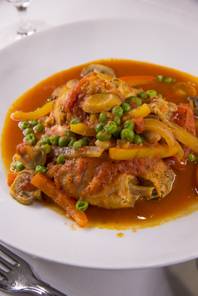
Chicken Cacciatore, from Fatimah Madyun
Madyun says that at first, cooking Rao’s food was “a little bit terrifying, because you have this legacy behind these recipes. There’s such a high expectation, but after a while it gives you comfort that people have been eating these dishes for so many years, and that we’re giving you this family feel but everything is plated beautifully and elevated.” She loves to make personal tweaks when she’s cooking a Rao’s classic at home, like adding peas to its chicken cacciatore and finishing the sauce with a couple tablespoons of butter for maximum richness.
1 bag Rao’s linguine
1 jar Rao’s Garden Vegetable Sauce
2 tbsp extra virgin olive oil
8 chicken thighs (optional: bones and skin removed)
salt and pepper
Bring a pot of salted water to a boil. Add linguine and cook al dente. Remove, rinse under cool water, drain well and set aside. Preheat sauté pan, add olive oil, season chicken with salt and pepper and add to pan. Brown chicken on all sides. Remove from pan and drain excess oil. Add Rao’s Garden Vegetable Sauce to pan along with any drippings. Stir ingredients together and simmer for 10-15 minutes or until chicken is cooked through. Place pasta on serving platter, add sauce and serve.
-
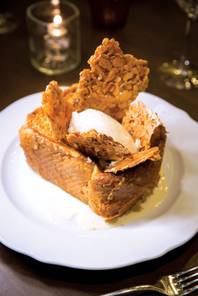
French Toast with Mascarpone Cream and Almond Brittle, from Josh Smith
Bardot Brasserie’s French toast was a happy accident. “I told the pastry chef to cut it 3 centimeters, and she heard 3 inches,” Smith says. The oversized toast looked and tasted so good, they decided to cut it even bigger. “It’s actually very simple to make, and really fun to share. It’s a good one to make Sunday for brunch at home with the family.” If the brittle seems too intimidating at first, you can always sub in quality store-bought granola for crunch.
Brittle
2 cups sugar
1 cup honey
1 tbsp butter
1 cup water
1/8 tbsp salt
2 cups almonds, sliced
Toast
1 whole brioche loaf
16 eggs
4 cups cream
4 cups milk
24 vanilla beans, sliced and scraped (or, to save money, use the equivalent in vanilla paste flecked with seeds or traditional vanilla extract)
16 tbsp sugar, plus 2 cups for caramelizing
4 pinches salt
2 oz orgeat syrup (made of almonds, sugar and rose water) to finish each serving
Cream
1 cup mascarpone
3 tbsp powdered sugar
3 vanilla beans, sliced and scraped
For brittle, combine sugar, honey, salt and water and stir until sugar dissolves. Bring to a boil and cook until mixture reaches 300 degrees on a candy thermometer. Remove from heat and stir in almonds and butter, then spread over parchment paper on a cookie sheet to form a very thin layer. When fully cool, break brittle into random shapes and store in airtight container if prepared ahead. For toast, cut bread into 4-inch slices and allow to dry at room temperature for 24 hours. Mix eggs, cream, milk, vanilla bean seeds, 16 tbsp sugar and salt with a hand blender, then dip each piece of toast in batter until it stops bubbling, turning over a few times so air escapes. Layer toast on parchment paper and bake at 200 degrees for one hour. Allow to chill at room temperature until very cool to the touch. Heat a nonstick pan to medium with a drop of vegetable oil. Dip the flatter side of each piece of toast into sugar and caramelize in the pan. For the mascarpone cream, mix all ingredients until smooth, being careful not to overwork. Place warm toast on a plate, garnish with a scoop of mascarpone and a piece of brittle and drizzle with orgeat syrup.
-
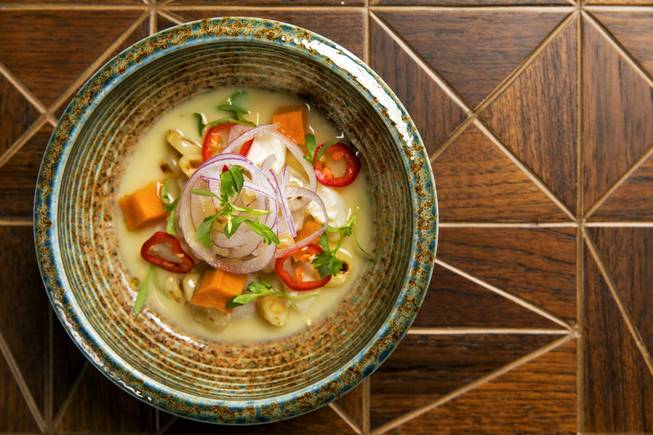
Ceviche Clasico with Corn Salad, from Lorena Garcia
This cool fish dish — even cooler because it’s marinated in leche de tigre, or “tiger’s milk” — is perfect for summer in Las Vegas. “It’s so nice and fresh and delicious, and it really is something easy you can keep and chill in the fridge,” Garcia says. She likes to serve it with Peruvian corn salad, but it’s a quicker win with just a side of your favorite tortilla chips.
Leche de Tigre
1/4 cup white onion, roughly chopped
1/2 celery stalk, roughly chopped
1/4 tsp garlic, minced
1/3 cup lime juice
1/4 cup lemon juice
1/2 cup fish stock
1 cup ice
1/2 tbsp kosher salt
1/8 tsp aji amarillo chile paste
1/2 tbsp cilantro, roughly chopped
1 tsp fresh ginger, peeled and grated
Ceviche
1 lb red snapper, cut into 1/4-inch cubes (2 or 3 reserved for leche de tigre)
1/2 tsp rocoto chile paste
1/4 cup red onion, finely chopped
1/2 red jalapeno, finely chopped
2 tbsp cilantro, finely chopped
1/2 tsp kosher salt
Salad
1/2 cup canned Peruvian corn
1/4 cup red onion, thinly sliced
1/2 red jalapeño, thinly sliced
1/2 cup lemon juice
1/2 tsp kosher salt
1/2 tbsp cilantro, finely chopped
For leche de tigre, add all ingredients and reserved fish cubes (for added creaminess) to a blender and blend until smooth, then strain and place in refrigerator. For ceviche, coat the bottom of large bowl with rocoto paste then mix in the rest of the ingredients. Add leche de tigre to ceviche and let sit for at least 5 minutes in the refrigerator before serving. For salad, mix all ingredients and let marinate for 20 minutes on the countertop before serving alongside ceviche.
-
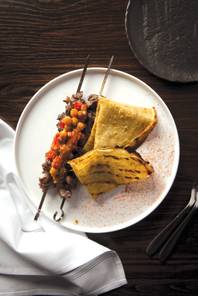
Beef Skewers with Chickpea Relish, from Brian Howard
“I was given this recipe by an Indian lady I worked with at one of my first jobs in Las Vegas, probably around 2001, and she just wrote it down for me and I came across it in a folder three months ago and had to find a way to fit it into my menu,” Howard says. “It’s just a brilliant marriage of delicious flavors.” His restaurant version showcases fat-ribboned wagyu beef and spikes the bean relish with a tamarind-date chutney, but you can ease in with more economical meat and a simplified accent.
Skewers
1 lb beef flap (sirloin) cleaned and sliced on a bias
6 cloves garlic, peeled and chopped
1/3 cup olive oil
2 tsp black peppercorns, toasted and ground
1 orange peel, sliced
2 tsp garam masala
Relish
1 cup dried garbanzo beans
1/4 tsp turmeric
1/2 tsp cayenne pepper
1/2 tsp salt
juice of 1 lime
1/2 cup red bell pepper, finely diced
1/2 cup green bell pepper, finely diced
1/3 cup radish, finely diced
1/2 cup green onion, finely sliced
For relish, place garbanzo beans in large saucepot with 8 cups water and bring to boil. Lower heat and cook for an hour until tender, drain and reserve. Add turmeric, cayenne, salt and lime juice and toss well. Once cooled, add the vegetables and adjust seasoning with lime and salt. For the skewers, combine all ingredients and marinate for 8 hours. Using metal skewers, thread the beef into 4-ounce portions and grill until meat reaches desired doneness.
-
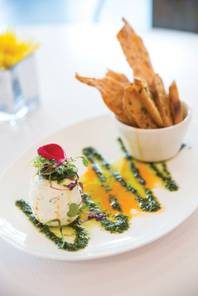
Pesto Torte, from Dalton Wilson
If you’ve been to DW Bistro, chances are you’ve ordered this appetizer — every time you’ve been. “It really is a crowd-pleaser,” Wilson says. It’s served with lavash and crostini crackers, but you can dip almost anything into this creamy, cheesy masterpiece.
8 oz cream cheese
8 oz goat cheese
1/4 cup buttermilk
1 bunch fresh basil, stems removed
4 oz pine nuts, toasted
1 cup Parmesan cheese, shredded
1 tsp garlic, minced
3/4 cup extra virgin olive oil
salt and pepper to taste
Add basil, pine nuts and garlic to a food processor and pulse to combine. Turn processor on and add olive oil in a steady stream until mixture becomes a smooth paste. Turn off machine and add Parmesan, pulsing to just combine. Season with salt and pepper. In a large bowl, combine the cream cheese, goat cheese and buttermilk and stir until combined. Season with salt and pepper and form into a ball. Serve with pesto drizzled on top and your choice of cracker.
-

Cinnamon Biscuits with Berry Jam, from Natalie Young
An order of Eat’s fresh biscuits and jam is a must-have for breakfast or brunch, and it’s one of Young’s personal favorites.
Biscuits
6 cups all-purpose flour
4 tbsp baking powder
1/4 tsp salt
3 sticks cold butter, cut into large pieces
3 1/2 cups whole milk
1 stick butter, melted
Cinnamon and sugar to taste
Jam
1 pint fresh blackberries
1 pint fresh blueberries
1/2 lb fresh strawberries, halved
1 cup natural cane sugar
1 pinch kosher salt
For jam, combine sugar and berries in a bowl and let macerate for 10 minutes or until sugar starts to dissolve. Transfer to a heavy pot, add salt and bring to a boil, then simmer on low for 10 to 15 minutes, until fruit starts to break down. Place in a glass jar to chill, then move to refrigerator for up to three weeks (or freeze). For biscuits, preheat oven to 350 degrees. Place flour, baking powder and salt into food processor and pulse to combine. Add butter and pulse until mostly combined, then drizzle in milk, being careful not to over-mix. With a large kitchen spoon, drop spoonfuls of biscuit mix onto a baking tray. Bake until golden brown, 20 to 25 minutes. Mix 1/2 cup sugar with 2 tablespoons cinnamon. When biscuits are cool, cut in half and brush insides with mixed cinnamon and sugar. Caramelize the biscuits cut-side down in a sauté pan on low, then serve with jam.
-

Pea Hummus, from Timon Balloo
A lovely summer snack, this easy dish is “light and clean, and you can even do it in a blender with frozen peas,” Balloo says. “Try spreading it in a sandwich, too.”
1 cup peas
1 tsp garlic, minced
2 1/2 tbsp water
1 1/4 tbsp honey
1 tbsp tahini
1 tsp lemon juice
1 tbsp sunflower seeds, toasted
1 tbsp sesame oil
pinches of mint, chives and Italian parsley, all chiffonade
1 lemon, zested
Combine peas, garlic, water, honey, tahini and lemon juice in blender and purée to a smooth paste. Serve garnished with sunflower seeds, drizzled with sesame oil, sprinkled with herbs and finished with preferred amount of fresh lemon zest.
Kitchen Cheat Sheet
Here's a guide to what you'll need to make our chef-approved recipes, as well as some of their favorite tools. It's a balance of budget-conscious and built-to-last.
Stockpot: The deep dimensions work for making soups and pastas, boiling seafood or corn, brewing beer and deep frying. • Good buy: Le Creuset’s 6-quart enamel-on-steel stockpot is designed for even cooking and flavor infusion. $65 at lecreuset.com
Cutting board: Plastic may be easier to clean, but it also gets deeper grooves from knife cuts (hence, more embedded bacteria) than solid wood. • Good buy: Bamboo is harder on knives than wood, but it’s more sustainable and absorbs less liquid. Ikea’s Lämplig is all sleek utility. $17 at Ikea, 6500 Ikea Way
Nonstick pan: Nonstick pans are an aspiring chef’s best friend. Go for a larger, lightweight model with a lid to serve the most functions. • Good buy: The 10-inch Restaurant Pro Aluminum Nonstick Skillet from Farberware is a durable, reasonable starter pan. $25 at farberwarecookware.com
Mandoline (Chef’s Pick): Ever wondered how restaurants make those superfine ribbons or shreds of carrot, radish, cucumber or potato? • Good buy: Oxo makes the finest cuts safe and easy with line-guided thickness adjustment and a clear surface for viewing the slice pile. $15 at oxo.com
All-purpose knife: Don’t skimp here. A versatile knife means you don’t have to invest in a whole block of specialty blades. • Good buy: The 8-inch J.A. Henckels classic chef’s knife is Epicurious’ pick for best workhorse for the money. $55 at cutleryandmore.com
Thermometer: Digital thermometers are the rage, and you don’t need an expensive one to get a solid reading on meat or sweets. • Good buy: The long probe on Smartro’s Instant Read means you can keep your distance from hot food, and it promises a read in 3 to 7 seconds. $11 at grill.ws
Baking sheet: Whether you’re making fresh cookies or crisping up leftover pizza, a baking sheet is a kitchen fundamental. • Good buy: Food & Wine’s pick is the industrial Nordic Ware Baker’s Half Sheet. It won’t warp in the heat and browns evenly. $19.50 at nordicware.com
Measuring utensils: Chefs recommend following recipes to the letter until you can cook by feel. So measure for precision, especially when baking. • Good buy: You can always upgrade, but Smartkitch’s 10-piecer is an inexpensive entry set made of stainless steel with etched-in quantities. $13 at amazon.com
Fish spatula (Chef’s Pick): This isn’t the fat plastic standard. It’s designed for turning the delicate catch of the day with angled, slotted metal. • Good buy: The 6.5-inch Wüsthof Pro might require handwashing, but the elegant steel head deserves it. $14.95 at swissknifeshop.com
Food processor: Super-sharp blades can do refined prep work, from chopping vegetables to pulverizing garlic to pulsing pastry dough. • Good buy: The Hamilton Beach two-speed with pulse has a large enough feed for an entire block of cheese. $37 at hamiltonbeach.com
Blender: Blenders are great for quick mixing and puréeing, with higher-end versions capable of more sophisticated food processing. • Good buy: Black+Decker’s PowerCrush is good for making everything from smoothies to soups to crumbs for cooking, and the parts are dishwasher-safe. $20 at target.com
Instant Pot (Chef’s Pick): This Canadian-designed wonder is said to speed up cooking by two-to-six times, using up to 70 percent less energy in the process. The “intelligent multicooker” can replace your pressure cooker, slow cooker, rice cooker, sauté pan and steamer. $145 at instantpot.com
Molcajete (Chef’s Pick): Not just for dramatic presentation of a Mexican mixed grill, this solid stone bowl is made to grind food like a mortar and pestle. Crush your spices or make guacamole, knowing that the porous basalt will “season” with absorbed flavors over time. • Good buy: Sur la Table sells a proper 5-inch molcajete with pestle, both made of volcanic rock in Mexico. $30 at instantpot.com















Join the Discussion:
Check this out for a full explanation of our conversion to the LiveFyre commenting system and instructions on how to sign up for an account.
Full comments policy